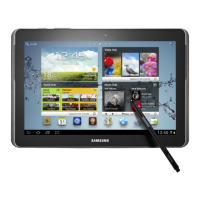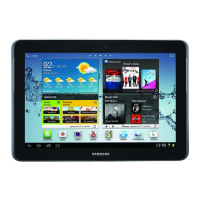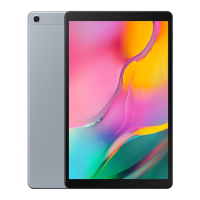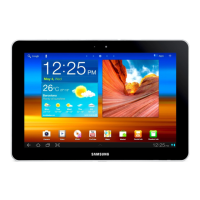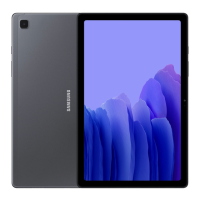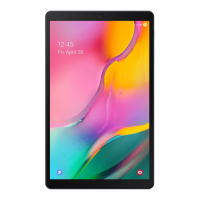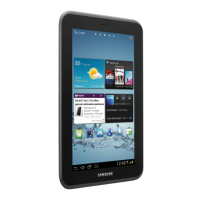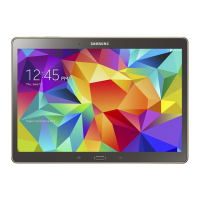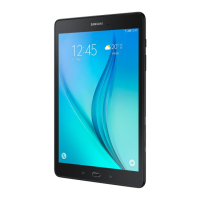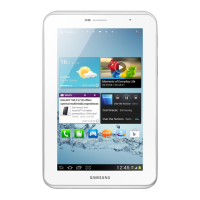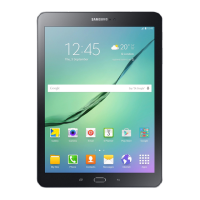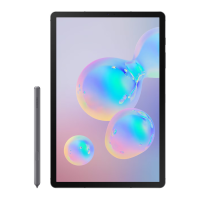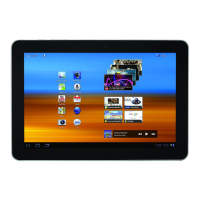
Do you have a question about the Samsung Galaxy Tab Galaxy Tab 10.1 16GB and is the answer not in the manual?
| Display Size | 10.1 inches |
|---|---|
| Internal Storage | 16GB |
| Operating System | Android 3.1 (Honeycomb) |
| RAM | 1GB |
| Front Camera | 2 MP |
| Battery | 7000 mAh |
| Resolution | 1280 x 800 pixels |
| Dimensions | 256.7 x 175.3 x 8.6 mm |
| Weight | 565 g |
| Connectivity | Bluetooth 3.0 |
| Processor | 1 GHz dual-core Tegra 2 |
Company details and contact information.
Explains the structure and content of the user manual.
Defines special text conventions used in the manual for emphasis.
Lists the main hardware and software features of the device.
Describes the starting point of device usage and its elements.
Explains how to use command buttons and the touch screen for navigation.
Explains the use of the on-screen QWERTY keyboard for text entry.
How to cut, copy, paste, and select text within fields.
How to store and manage contact information for friends and colleagues.
Steps to add new contact entries with details like name, phone, and email.
Lists supported message types: Gmail, Email, and Google Talk.
How to send and receive email using your Google account.
How to view and manage all your email accounts in one application.
Methods to open the Settings menu and access device configurations.
Manages device's wireless connections like Wi-Fi and Bluetooth.
Discusses potential health effects from radio frequency energy exposure.
Addresses concerns about cell phone radiation and health risks.
Explains what is covered, for how long, and what is not covered.
Outlines Samsung's responsibilities under the warranty, including repair or replacement.
Explains the structure and content of the user manual.
Defines special text conventions used in the manual for emphasis.
Explains the icon in the Status Bar that shows battery power level.
Describes Back, Home, and Recent Apps buttons.
Explains touch gestures for interacting with the screen.
Explains the use of the on-screen QWERTY keyboard for text entry.
Introduces the custom keypad with predictive text features.
Information on synchronizing various types of accounts like Google and Email.
How to store and manage contact information for friends and colleagues.
Steps to create a new group for organizing contacts.
How to add or remove contacts from the Favorites list.
Lists supported message types: Gmail, Email, and Google Talk.
How to send and receive email using your Google account.
Steps to set up email accounts, including server settings.
How to sign in or create a Google account to use Talk.
Discover, buy, and enjoy books online and offline using Google eBooks.
Options for web navigation, including command keys and gestures.
Steps to create a bookmark for a website.
How to zoom, scroll, and interact with map elements.
How to share your location with friends via Latitude.
Play music and other audio files copied from your computer.
Steps to play a song from your library.
Use the built-in camera and camcorder to take photos and record videos.
Steps to compose and take a photo using the camera.
Display options like Details, Show on map, Rotate, Set picture as, and Crop.
Steps to compose and record a video using the camcorder.
Display options like Details, Show on map, Rotate, Set picture as, and Crop.
Steps to start a new movie project in Movie Studio.
Wireless networking technology for accessing local area networks.
How to configure Wi-Fi settings for device connections.
Steps to turn the device's Bluetooth service on or off.
Achieve real-time, GPS-enabled navigation and access local searches.
Configure language, SafeSearch, and blocking of offensive words.
Configure voice output for audible readout of text.
Steps to add and configure a new alarm with time, repeat, ringtone, and label.
Display information about apps installed on your device.
Methods to open the Settings menu and access device configurations.
Manages device's wireless connections like Wi-Fi and Bluetooth.
Allows use of device features while disabling wireless communication.
Manages Wi-Fi connections, networks, and advanced settings.
Steps to turn the device's Bluetooth service on or off.
Steps to add a VPN connection, choosing from PPTP, L2TP, or L2TP/IPSec protocols.
Enable or disable device vibration for notifications.
Set the volume level for system sounds, notifications, and alarms.
Set the default screen brightness or use automatic brightness.
Manage location services and enable wireless network usage for location.
Configure settings for unlocking the screen with patterns or passwords.
Install encrypted certificates from a storage device via USB.
Set or change a password to protect credentials.
Enable debugging when the device is attached to a PC via USB.
Configure background data and auto-sync settings.
Enable or disable backup of information to the Google server.
Reset the device to factory defaults, erasing all data.
Set the language used by your device.
Configure language, SafeSearch, and blocking of offensive words.
Configure voice output for audible readout of text.
Choose the default text entry method.
Enable or disable accessibility services like TalkBack.
Enter the current date.
Enter the current time.
Choose your local time zone.
Connect to network and download new software updates.
View battery status, IP address, MAC address, and uptime.
Check for and apply software updates.
Discusses potential health effects from radio frequency energy exposure.
Addresses concerns about cell phone radiation and health risks.
Simple steps to minimize RF exposure, like reducing usage time.
Warning against exposing the device or battery to liquids to prevent corrosion.
Warning that the display is made of glass/acrylic and can break if dropped.
Disclaimer on proper touch-screen usage to avoid damage and voiding warranty.
Lists conditions and substances to keep the device away from.
Provides guidance on listening safely to avoid potential hearing loss.
Recommendations for maintaining separation between mobile devices and implantable medical devices.
Warnings about voiding warranty, using unauthorized accessories, and handling the device.
Explains what is covered, for how long, and what is not covered.
